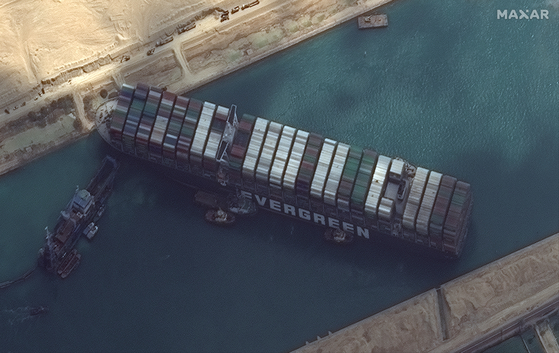
Satellite image of a container ship stranded on the Suez Canal. Reuters = Yonhap News
As the passage of the Suez Canal was blocked due to the aground of the large cargo ship Ever Given, the number of ships waiting on the outskirts of the canal increased to more than 200, and the shipping congestion increased.
According to CNN broadcast on the 26th (hereafter local time), experts on dredging operations of the US Navy stationed in the Middle East will arrive at the site of the Suez Canal stranded on the container ship Evergiven as early as the 27th.
In addition to more than 200 ships waiting near the Suez Canal, more than 100 ships are heading for the Suez Canal, according to data company Refinitive.
US Navy officials are said to look at the site and consider how to support the Egyptian authorities’ restoration work.
Earlier in the briefing, White House spokesman Jen Saki said in the briefing that “we are watching the impact on the energy market.” We are discussing how to help in the best way,” CNN said.
The work to re-float the Panamanian container ship Evergiven, which had been stranded while blocking the Suez Canal, was suspended late on the 26th local time and is expected to resume on the 27th.
The dredging and towing work to get the stranded ship out of the canal continued for four days until the 26th, but it is not easy to float a huge ship with a prow stuck in the embankment.

Dredger put into the accident site provided by Suez Canal Management Office = Yonhap News
Bernard Schulte Marine Management (BSM), who is in charge of the hull flotation operation, said that the operation was carried out until the afternoon of the 26th, but was not successful in floating the hull on water.
BSM and rescue company Smit Salvage added that they decided to support the hull lift by putting two additional tugboats at the site on the 28th. There are already 9 tugboats on site.
BSM said, “The core of the work will be dredging to remove the sand and mud from the starboard bow of the ship.”
A special suction type dredger capable of transferring 2000㎥ of sand per hour was put in for the dredging work to remove the head of the boat stuck in the bank of the canal.
The Suez Canal Management Administration (SCA) announced that by this day, a total of 17,000㎥ of sand and mud has been scooped out, and 87% of the total dredging work has been completed.
According to the authorities, a maximum total of about 20,000㎥ must be dredged to re-float the boat, which is eight times the volume of the Olympic swimming pool. Dredgers are struggling to work, especially in the prow.
The dredging work, which started at a depth of 0.5m above the ground, has progressed to 15m, and a high-performance pump will also be used to lower the water level in the area where the ship was aground. However, it is difficult to move a huge ship with a length of 400m, a width of 59m, and a gross tonnage of 224,000 tons. Since there are about 20,000 containers on board, it is unclear whether the problem can be solved with only dredging and towing.
Some ships start changing routes to Africa

In Egypt’s Suez Canal, an excavator is scooping dirt from the bottom of the Evergiven, a super-large container ship that blocks the canal. The Evergiven was stranded and blocked the canal two days ago when it encountered a strong wind and lost its steering ability while passing through the canal. AP Yonhap News
As the shipping congestion increased due to ships waiting outside the canal, some ships began to change their route through the Cape of Good Hope in Africa.
According to satellite maps, the owner of the Evergiven changed its route to Africa, as if expecting a long delay until it resumed traffic. In addition, the liquefied natural gas carrier Pan America is also changing its course toward the Cape of Good Hope in Africa, and other ships are also changing their direction to transit through Africa.
About 10% of world trade goes through the Suez Canal, especially for oil transport, the Suez Canal is of great importance. This suspension of traffic could have a major impact on oil and gas transport from the Middle East to Europe.
Reporter Bae Jae-seong [email protected]
![]()
